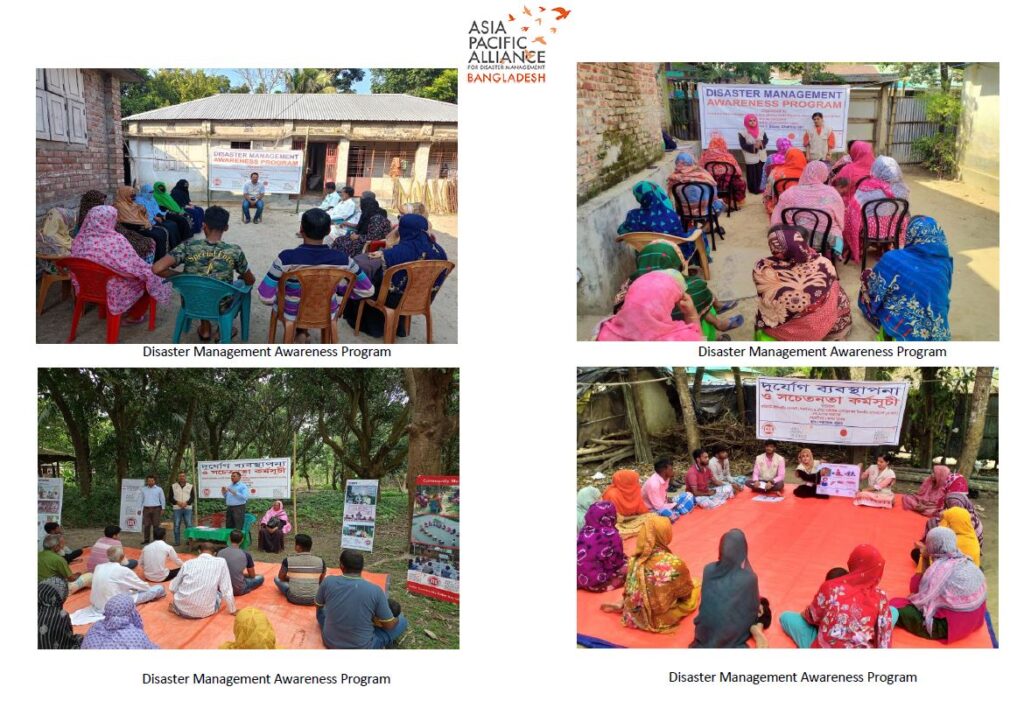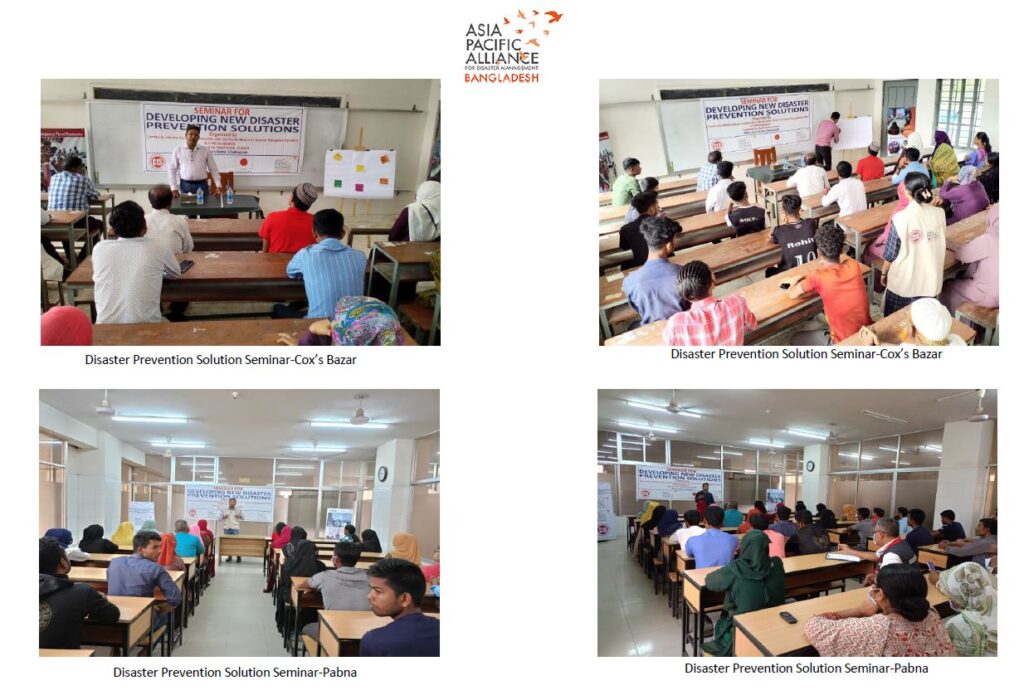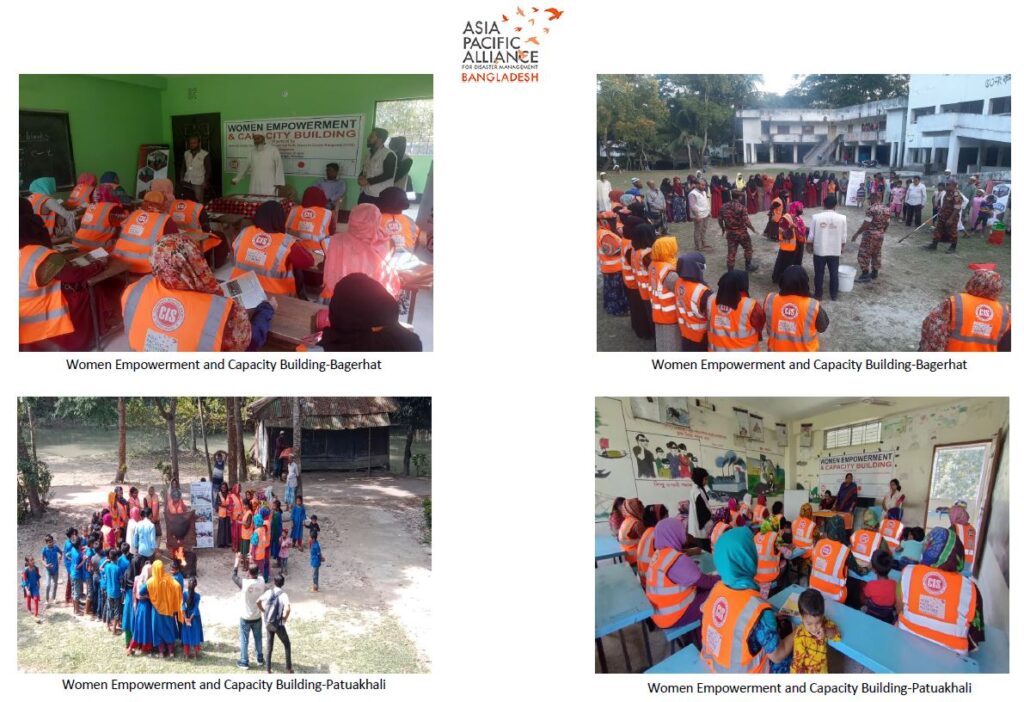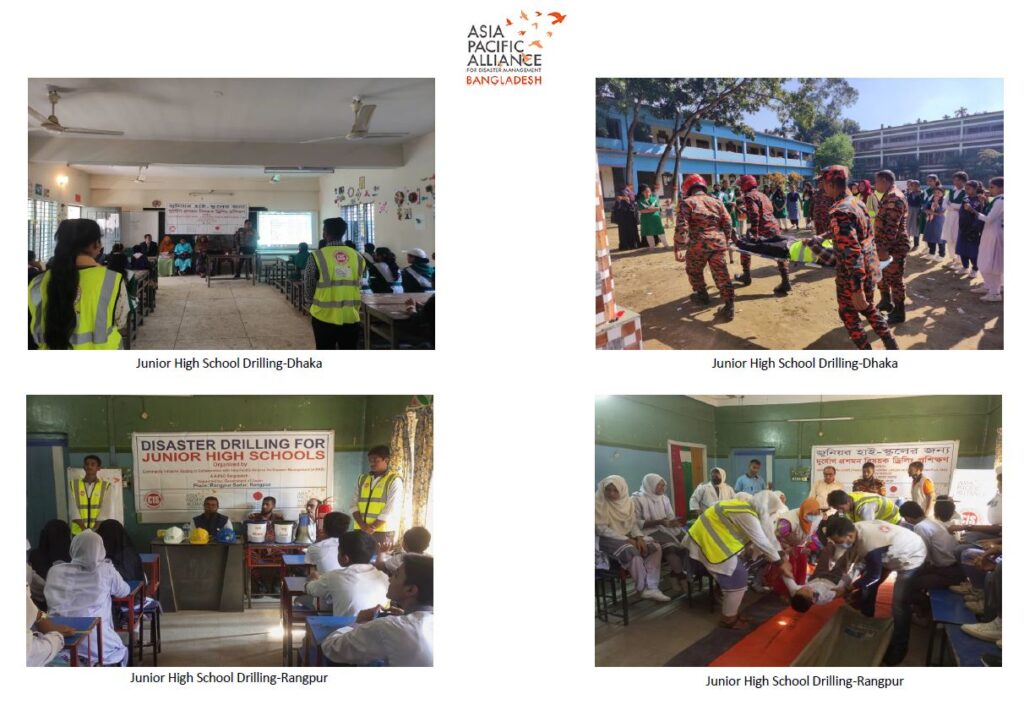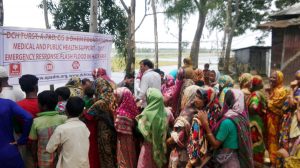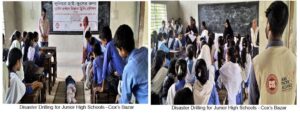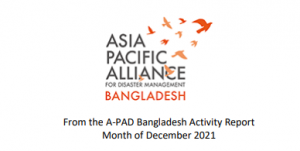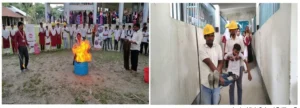Project Title: Strengthening Capacity for Sustainable Disaster Management Network by involving multi-sectoral platform Project Period: 17 January, 2023 – 16 January, 2024 (12 month)
- Project Activities and Accomplishments
Bangladesh is one of the most vulnerable countries to natural disasters and, due to climate change; we are facing natural disasters almost every year. Combined with the country’s geographical location, topography, and dense population, disaster events often result in high loss of life and economic loss, though Bangladesh has been successfully reducing the loss of human lives over the years. The frequency and intensity of natural disasters have increased in recent years due to climate change. The climatic events have serious consequences on broad agricultural sectors, food security, water, health, and sanitation and leave serious impacts on the life and livelihood of the communities. But so far we have limited disaster risk-related data to understand the depth of household and population characteristics and loss sustained by the community at the household levels.
A-PAD Bangladesh started the project in January 2023 and presently continues it on 17 January 2023 to build up capacity for disaster management. It communicates with the different sectors like the local community, community leaders, stakeholders, and GOVT. officials continuing training on disaster management. To hold a training program A-PAD Bangladesh staff organized small community meetings to share ideas on disasters and introduced them about A-PAD Bangladesh activity. A-PAD Bangladesh working 8 divisional areas.
There are 1 health workers in each divisions whose are doing home visit and aware the local community about basic disaster awareness. The health workers gave basic ideas about disaster management. A-PAD Bangladesh working at the rural areas. If there would be any directions or announcement from GOVT. or any disaster related news has been published the health workers delivered the message to the local community. Total 6,728 persons were benefited from A-PAD Bangladesh on November 2023.
A-PAD Bangladesh attended coordination meeting at the 8 divisions in Office of Deputy Commissioner. At that meeting different NGOs had joined and explained their activities. Besides this what will be the next activities of the GOVT. and NGOs were discussed at that meeting.
1. To manage the emergency disaster management coordination centers in disaster-prone areas (Outcome 1) The disaster management coordination center in disaster-vulnerable areas established in this project (3 year project) functions as a disaster response base in each region, and contributes for preventing the spread of health damage to local residents and community-led disaster risk reduction measures. | ||
Activities | Outcome Indicators to Measure Results: | Project Status: Achievements vs Outcome: If the activity is behind schedule, please write the reason. |
1-1 Operation of Emergency Disaster Management Coordination Centers Beneficiaries: 10 people x 25 days x 8 divisions x 12 months = 24,000 people 50 people x 8 campaign x 12 months = 4,800 people | 【Indicators of Outcome】 1-1: The disaster response management centers in 8 places (Dhaka, Chattagram, Rajshahi, Khulna, Barisal, Sylhet, Rangpur and Mymensingh division) will be utilized and the necessary equipment for emergency health care will be prepared. We will establish a new emergency disaster management coordination center in Mymensingh division. The center will function as a resource center for sharing information on disasters and will be used as a venue for strategic planning meetings, training and workshops. The staff members including doctors and nurses visit the villages and carry out awareness activities related to emergency health measures, public health and disaster prevention for local residents, and ensure that each local resident takes appropriate preventive measures. | Total of 4,483 people visited the Disaster Management Coordination Center to discuss disaster preparedness and health-related issues. Dhaka: 725 Persons Cox’s Bazar: 520 Persons Pabna: 475 Persons Bagerhat: 483 Persons Patuakhali: 540 Persons Habiganj: 610 Persons Rangpur: 550 Persons Netrokona: 580 Persons Total = 4,483 Persons |
1-2 Disaster Management Awareness program Beneficiaries:15 participants x 3 sessions x 8 divisions x 12 months = 4,320 people | A-PAD Bangladesh conducted Disaster Management Awareness programs at the 8 divisional areas where 388 persons participated. Total 3 times training was organized at each divisional area. Dhaka:15 Participants x 3 Sessions= 45+2=47 Participants Cox’s Bazar: 15 Participants x 3 Sessions=45+5=50 Participants | |
| (Indicator: number of visitors, record of services provided)
1-2: The PCR test lab installed in the previous project will continue to operate. In the first year of the project, testing will be conducted only for COVID-19. From the second year onwards, it will be expanded to other infectious diseases (tuberculosis, measles, hepatitis) according to the needs of local residents. (Indicator: number of tests, report of test results) | Pabna: 15 Participants x 3 Sessions= 45+6=51 Participants Bagerhat: 15 Participants x 3 Sessions= 45+4=49 Participants Patuakhali: 15 Participants x 3 Sessions= 45+5= 50 Participants Habiganj: 15 Participants x 3 Sessions= 45+3= 48 Participants Rangpur: 15 Participants x 3 Sessions= 45+2=47 Participants Netrokona: 15 Participants x 3 Sessions= 45+1=46 Participants |
1-3 Operation of PCR lab Beneficiaries: 15 people x 25 days x 12 months = 4500 people(Monthly Goal: 15 persons x 25 days = 375 persons) |
A-PAD Bangladesh established PCR Lab for COVID-19 test. In Bangladesh, number of fever patients has average in number. In November 2023 total 395 COVID-19 test has been done | |
2 Strengthening the disaster response platform network (Outcome 2) A-PAD BGD, NPF for disaster reduction and disaster response through collaboration between multi-sectors, will be established and expanded, and the disaster prevention and disaster capacity of its member organizations will be strengthened. | ||
2-1 Network partner meeting Participants : 100 people x 5 villages x 8 divisions = 4000 people | 【Indicators of Outcome】 2-1 Strategies, mechanism and action plan meeting among networking partners and local communities will be held to support the building of disaster cooperation framework.
2-2 For the aim of awareness and increase the knowledge on disaster preparedness and management among the local community, we will organize different rally and meeting on the disaster preparedness and SDGs related |
|
2-2 Disaster Preparedness Campaigns
Participants:100 people x 2 times x 8 divisions = 1,600 | A-PAD Bangladesh conducted Disaster preparedness campaign at the 8 divisional areas where 100 people has participated in disaster preparedness campaign. 05 November 2023, Dhaka, Total Participants 100 05 November 2023, Cox’s Bazar, Total Participants 100 | |
people | national/international days like 05 November World Tsunami Awareness Day, 13 October Disaster Risk Reduction Day, 22 April Earth Day and 16 December Victory Day (National).
2-3 For the aim of strengthening of partner organizations, disaster risk reduction (DRR) training will be held. The training contents includes community-based disaster risk management, planning DRR strategies, and risk analysis that effectively identifies hazards, capacities and vulnerabilities. (Indicator: Partner organizations)
2-4 In this seminar, participants from various fields will be invited to exchange opinions and discuss ways to discover innovations related to DRR proposed by community residents and local companies and realize ideas and inventions. (Indicator: To create innovative solutions, we aim to create a successful model for disaster response by combining technology and knowledge that transcends fields and innovating)
2-5 The international symposium will be held in Dhaka to widely share the cooperation between multi-actors | 05 November 2023, Pabna, Total Participants 100 05 November 2023, Bagerhat, Total Participants 100 05 November 2023, Patuakhali, Total Participants 100 05 November 2023, Habiganj, Total Participants 100 05 November 2023, Rangpur, Total Participants 100 05 November 2023, Netrokona, Total Participants 100 Rally was organized from the selected points in each areas where various organization attend. After the rally it was organized the seminar and next action plan for the disaster preparedness. |
2.3 Network Partners Capacity Strengthening (DRR) Participants:30 people x 2 org x 8 divisions x 2 times =960 people |
| |
2-4 Seminar for Developing New Disaster Prevention Solutions Participants:40persons x 8 divisions x 2times =640 participants | A-PAD Bangladesh organized Seminar 2 divisional areas Cox’s Bazar and Pabna.
18-19 November 2023, Cox’s Bazar, Total Participants 40+3 20-21 November 2023, Pabna, Total Participants 40+1
CIS conducted a Seminar for Developing New Disaster Prevention Solutions at the Convention Hall of Kurushkul High School, Cox’s Bazar Sadar. Government, Non-government |
| at the central and regional levels in Bangladesh and the progress of the emergency health response system among participants who are involved in disaster response from inside and outside Bangladesh. International experts will be dispatched from A-PAD member countries to introduce advanced cases of NPF in each country. (Indicator: The international symposium will be held for a total of three days, one day for field trips (field visits), one day for pre-meetings, and one day for international symposiums.) | Organizations, NGO’s and Local Leaders were presented at the seminar. Disaster preparedness therefore has two main aims to help people avoid impending disaster threats and to put plans, resources and mechanisms in place to ensure that those who are affected receive adequate assistance. A disaster preparedness ‘plan’ can take several forms, ranging from a broad mitigation and preparedness strategy to a detailed contingency plan for responding to a particular hazard. Mr. Nazim Uddin ( Head Teacher, Kurushkul High School) was present as a Chief Guest he focused on how to mitigate and plan the upcoming disaster events in Cox’s Bazar. Further, discussed what preparation can be taken for the early disaster so that it will help to reduce the loss of lives. Both the public and private sector’s emergency prevention, preparedness, response and recovery efforts benefit by extending training on preparedness to private sector employees who helps to raise awareness within a private sector organization of emergency plans and procedures, potentially reducing the impact of incidents on personnel, assets and operations. At the seminar, Public and Private Partners concluded that All sectors will come forward to work and collaborate during the disaster.
Through this seminar, the participants can explore new approaches and technologies to improve disaster prevention and management, develop networks and collaborations, and identify potential areas for further research and development. |
|
| Ultimately, the seminar aims to contribute to building a safer and more resilient society, better equipped to face the challenges posed by disasters. In this Seminar Govt. official shared their plan on Disaster Management and said that people now are more practical regarding disaster Management. During disasters, people try to keep them safe and also try to prepare for future events which can cause loss of human life. Building resilience and disaster preparedness play an important role Disasters will occur we can’t stop them but if we prepare ourselves for them we can easily cope with the situation and the loss will be less. In the feedback session, they shared that this kind of seminar is very helpful and this kind of seminar helps the community people, community leaders, private sector, and stakeholders to take action on disaster risk management. |
2-5 International Symposium on DRR
Participants:200 persons |
Community Initiative Society (CIS) and A-PAD Bangladesh are collaboratively organizing an International Symposium on 07 November 2023 “Supporting Improvised Communities in Emergency Management Using Diversity and Inclusion” in connection with the project, which will take place in Dhaka. This international symposium will help to ensure comprehensive participation and support of NGOs, private organizations, business groups, and governments for establishing a multi-sectorial platform of APAD Bangladesh building community resiliency, and leading the effectiveness of |
|
| humanitarian response at the national level. The goal of the Symposium is “ To increase access to resources and tools that facilitate more comprehensive inclusion of planning with people with access and functional needs, including improvised communities as well as other groups disproportionately impacted in emergencies” Diverse and inclusive emergency management practices build trust and credibility within communities. Total of 255 participants joined the symposium physically and virtually where 203 participants joined physically and 52 joined virtually. Among them, A-PAD International and Local Platforms from member countries, Government, Universities, partners, NGOs, School Teachers and private sector, and Local Communities from the seven divisions Dhaka, Rajshahi, Sylhet, Chattagram, Khulna, Rangpur, Barisal, and Mymensingh representatives gathered in the Symposium. |
3. Strengthening disaster resilience of local communities
(Outcome 3) 3-1 Disaster response capacity building of local community level in Health and hygiene field | ||
3-1 a) ) Workshop on Disaster Management and Emergency Health Response
Participants:40 persons x 8 | 【Indicator of Outcome】 3-1 a) Workshops will be held to understand emergency disaster preparedness, health response and hygiene needs in communities, schools and homes and to learn how to respond | A-PAD Bangladesh organized workshop in Habiganj and Rangpur.
19-20 November 2023, Habiganj, Total Participants 40+2 25-26 November 2023, Rangpur, Total Participants 40+5 |
divisions x 2 times = 640 persons | during emergencies. Networks of stakeholders will be built through the workshop.
(Indicator: Local citizens, Community leaders, Local NGO, Private sector workers)
b) Workshop for healthworkersfrom local organizationswillbeheld to understand emergency health and hygieneneeds and learn how to respond to emergencies. The healthworkerswhofinishedthis trainings are supposed to becomemember of disastervolunteerrescue team in the activity. | Through the sharing of experiences, best practices, and the latest research findings, participants in the workshop can gain valuable insights into successful strategies and innovative approaches in disaster management. This collective knowledge can inform the development of more robust policies, improve coordination mechanisms, and strengthen the overall resilience of communities in the face of diverse and unpredictable challenges. The objectives of the Workshop on Disaster Management and Emergency Health Response, organized by the Community Initiative Society (CIS), are as follows: · Promoting Preparedness: The workshop aimed to highlight the critical importance of preparedness in facing disasters. By bringing attention to proactive measures, it sought to equip professionals and practitioners with the knowledge and tools necessary to enhance community readiness and responsiveness. |
|
| · Building Resilience: The workshop emphasized the need to build resilience within communities and healthcare systems. Participants explored strategies to strengthen the ability of individuals and institutions to withstand and recover from the impact of disasters, both in terms of infrastructure and human resources. · Knowledge Sharing and Exchange: A central objective was to provide a platform for professionals, experts, and practitioners to share their knowledge, experiences, and insights. The workshop facilitated open discussions on successful approaches, lessons learned, and innovative strategies in disaster management and emergency health response. · Enhancing Interdisciplinary Collaboration: Recognizing the multifaceted nature of disaster response, the workshop aimed to foster collaboration among diverse stakeholders. By bringing together professionals from various fields, including government agencies, healthcare, and non-governmental organizations, it |
|
| sought to promote a holistic and coordinated approach to disaster management. · Identifying Best Practices: Participants actively engaged in discussions to identify and discuss best practices in disaster management and emergency health response. The goal was to extract valuable lessons from past experiences and ongoing initiatives, to inform future policies and actions. · Improving Emergency Health Response: A specific focus was placed on emergency health response, emphasizing the crucial role of the healthcare sector in mitigating the immediate and long-term health impacts of disasters. The workshop aimed to explore and disseminate best practices in delivering timely and effective healthcare services during crises. The workshop aimed to create a collaborative environment by bringing together individuals with varied backgrounds and expertise. The participants as follows: |
|
| · Disaster Management Professionals: This group comprised individuals with expertise in disaster risk reduction, emergency planning, and disaster response coordination. They brought practical experience and insights into managing the various phases of disasters, from preparedness to recovery. · Healthcare Practitioners: Participants from the healthcare sector included doctors, nurses, public health professionals, and administrators with experience in emergency medical response. Their perspectives were crucial in discussing strategies for providing effective healthcare services during and after disasters. · Government Representatives: Officials and policymakers from local, regional, and national government agencies involved in disaster management and public health were likely participants. Their involvement was essential for understanding and influencing policy frameworks related to disaster preparedness and response. |
|
| · Non-Governmental Organizations (NGOs): Representatives from NGOs involved in disaster relief and recovery efforts were likely present. These organizations play a vital role in providing on-the- ground support, and their experiences contribute significantly to the collective knowledge base. · Community Leaders: Local community leaders and activists who play a crucial role in grassroots-level disaster preparedness and response were also likely to be part of the workshop. Their firsthand knowledge of community dynamics and needs is instrumental in shaping effective strategies. |
3-1 b) Training of Local Health Workers on Disaster Health Activities
Participants:25 pers/time x 8 divisions = 200 persons |
| |
3-2 Strengthening disaster response capacities of local communities through disaster drilling training | ||
3-2 a) Women Empowerment and Capacity Building Participants:20 persons X 8 Divisions X 2 Session = 320 participants | 3-2 a)Building women empower and capacity building through improving their knowledge and skills on disaster risk reduction, in order to involve them in disaster planning and policy making. A women’s group will be trained in the field of maternal and child health, hygiene and environment sanitation, nutrition. (Indicator: A women’s group will be trained in the field of maternal and child health, hygiene and environment sanitation, nutrition.)
b) Drilling training session will be conduct to the local stakeholders, youth group and homes and to learn how to respond the fire, flood, cyclone, landslide and earthquake disasters and rescue at the emergencies. To conduct this training session, we will prepare a training manual and a curriculum collaboration with the department of fire service and civil defense of GoB. (Indicator: After the practical training session two disaster volunteer rescue team will be established in each divisional area.)
c) Drilling training session for the public junior high | A-PAD Bangladesh organized Women Empowerment Capacity Building Training in 2 divisional areas.
11-12 November 2023, Bagerhat, Total Participants 20+3 14-15 November 2023, Galachipa, Total Participants 20+2 CIS conducted Women Empowerment and Capacity Building training in Bagerhat on 11,12 November 2023.As Bagerhat is one of the most disaster prone coastal area in Bangladesh people face disaster very often and all these incident make women’s lives in complex and dire. These incidents affect women’s physical and mental health. And they cannot live a normal life. Real development in the country and society is not possible without improving their condition. This training was organized 2 days. On the 1st day there was discussion on emergency response during cyclone as women in Bagerhat spent their maximum time in home and face cyclone most. CPP team member was there and discussed the necessary things what should do and what not to do. There was also workshop where the participants shared their experiences and their |
| school students and teachers will conduct at the school based focusing self-protection during and after disaster. Manual will be designed for the school children in cooperation with the department of fire service and civil defense of GoB (Indicator: Participated schools will be supported to develop their emergency management plans.)
In order to widely share and disseminate the activities of this project and the experiences and lessons learned through the activities, situation reports and activity reports in the event of a disaster will be published on the A-PAD BGD website. | ideas. On the 2nd day there was discussion on fire incidents and there was a drilling program on emergency fire incident response activities. On the 2nd day Md. Shidul Islam shared that One of the primary objectives of fire drills is to ensure that everyone is safe. By conducting regular evacuation exercises, individuals will be more aware of potential fire hazards and learn how to respond by identifying emergency exits and routes of evacuation. Quick and orderly evacuation helps minimize panic and injuries during an actual fire incident; by practicing, individuals can evacuate the premises calmly and organize. | |||
| On that day Anjana Rani, Head Teacher of Hoglebunia |
| |||
|
|
| Government Primary School cum Cyclone Center was present |
| |
|
|
| and she shared her experiences. She also shared why women |
| |
|
|
| should build their capacity and improve their condition.on the |
| |
|
|
| 2nd day there was demonstration of different type of activities |
| |
|
|
| such as how to rescue children who are about to drown, how |
| |
|
|
| to give CPR and how to manage fire incident. |
| |
|
|
| At present women empowerment is must for a resilient |
| |
|
|
| community Through different NGOs, training to the women |
| |
|
|
| which helps to formed to rescue people stuck in different |
| |
|
|
| situation in disasters for instance, how to rescue people if |
| |
|
|
| the sea water level rises. The people from coastal areas |
| |
| possess some indigenous knowledge which helps them to |
| |||
|
| safeguard themselves against disasters. In the training there was also discussion on this indigenous knowledge. |
3-2 b) Disaster Drilling for the Youth and Local Stakeholders Participants : 45 persons x 8 divisions x 2 times = 720 persons | A-PAD Bangladesh organized Disaster Drilling for the youth and local stakeholder in 2 divisional areas Pabna and Netrokona. 15-16 November 2023, Netrokona, Total Participants 45+1 28-29 November 2023, Pabna, Total Participants 45+3
During the Disaster Drilling Program for Youth and Stakeholders, a variety of drilling demonstrations and exercises are conducted to impart practical skills and knowledge related to disaster preparedness, response, and recovery. These drills help participants become better equipped to handle real-life disaster scenarios. Here are the typical drilling demonstrations that take place in the program: 1. Fire Safety Drill:
· Participants learn how to use fire extinguishers and evacuate a building in the event of a fire. They practice “Stop, Drop, and Roll” and proper fire evacuation procedures. |
|
| 2. Earthquake Drill:
· Demonstrations on how to “Drop, Cover, and Hold On” during an earthquake, as well as how to safely evacuate buildings after the shaking stops. 3. First Aid and Medical Response Drill:
· Participants learn basic first aid techniques, including wound dressing, CPR. They practice treating common injuries like cuts, burns, and fractures. 4. Search and Rescue Simulation:
· Training in how to conduct search and rescue operations, including locating and assisting injured or trapped individuals, using basic search and rescue equipment. 5. Shelter Setup and Management: |
|
| · Setting up emergency shelters and managing resources within a shelter, including organizing sleeping arrangements, food distribution, and sanitation facilities. 6. Emergency Communication Drill:
· Practice using various communication tools during disasters, such as two-way radios, cell phones, and emergency alert systems, to establish and maintain contact with emergency services and loved ones. 7. Evacuation Drill:
· Conducting evacuation drills from homes, schools, or community centers, following designated evacuation routes and assembly points. 8. Community Coordination Exercise: |
|
| · Participants work together to organize community response efforts, coordinate resources, and allocate responsibilities among community members. 9. Flood Preparedness Drill:
· Demonstrations on how to construct sandbags for flood protection and prepare for potential flooding, including evacuation plans and managing floodwaters. 10. Power Outage and Utility Shutdown Preparedness:
· Training on managing power outages, using backup generators, and ensuring the safety of gas and electrical systems. 11. Hazardous Materials and Chemical Spill Response: |
|
| · Learning how to respond to hazardous material incidents safely, including containment, isolation, and decontamination procedures. |
3-2 c) Disaster Drilling for Junior High Schools Participants : 45 persons x 8 divisions x 2 times = 720 persons | 02 days drilling programs for the Junior high school organized in Dhaka and Rangpur 12-13 November 2023, Dhaka, Total participants 45+2 13-14 November 2023, Rangpur, Total participants 45+5
Key Activities: 1. Simulation Exercises:The drilling event included realistic and dynamic simulation exercises to mimic various disaster scenarios, such as earthquakes, floods, and fires.Students actively participated in these exercises, applying theoretical knowledge gained through preparatory sessions. 2. Educational Workshops:Prior to the practical drills, educational workshops were conducted to provide students with a foundational understanding of different types of disasters, their potential impact, and the appropriate response strategies.Experts in disaster management shared valuable insights and practical tips to ensure students were well-informed. |
|
| 3. First Aid Training:Basic first aid training was provided to students, covering essential skills such as CPR, wound care, and handling minor injuries.Medical professionals and trainers were present to supervise and guide students during the first aid exercises. 4. Community Engagement:The drilling initiative involved the active participation of parents, teachers, and the broader community.Community members were briefed on their roles during emergencies and encouraged to collaborate in creating a safer environment. 5. Feedback and Evaluation:Continuous feedback was collected from students, teachers, and community members throughout the drilling event.After the drills, a debriefing session was conducted to assess the effectiveness of the exercises, identify areas for improvement, and gather suggestions for future initiatives. 6. Increased Awareness:The drilling initiative significantly increased awareness among Junior High School students about various disasters and the importance of preparedness.Students demonstrated improved knowledge of evacuation procedures and first aid techniques. 7. Community Collaboration:The active involvement of the community fostered a sense of collaboration and |
|
| shared responsibility for disaster |
preparedness.Parents and teachers expressed | ||
appreciation for the initiative and acknowledged its | ||
positive impact on the overall safety of the community. | ||
3-3 Update website contents as E-resources for Disaster | https://cis-bd.org/news-paper/ https://cis-bd.org/media-videos/ https://cis-bd.org/upcoming-events/ | |
Management |
|
- Challenges
Please write Challenges and its impact upon the project implementation. (Ex.lockdown, Political situation, Curfew)
- Practice in collaborationwithA-PAD Bangladesh Network Partners Disaster Management Awareness Program
Please write good practice in collaboration with partner organizations
- Any contributionFunds Received and Grants Applied / Planned and Implemented Projects by CIS including Emergency Response Please write Projects name and its fund resources
- Relationship with Bangladesh Government and Japanese Embassy Please write about Meeting with Government officials
